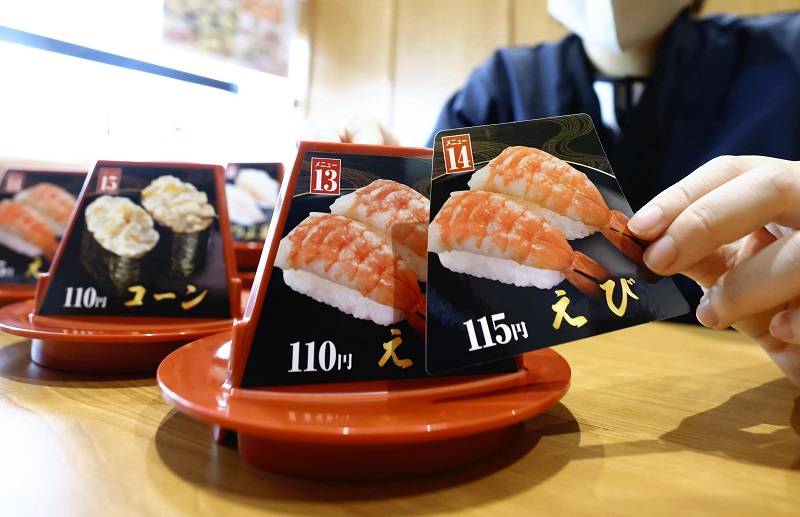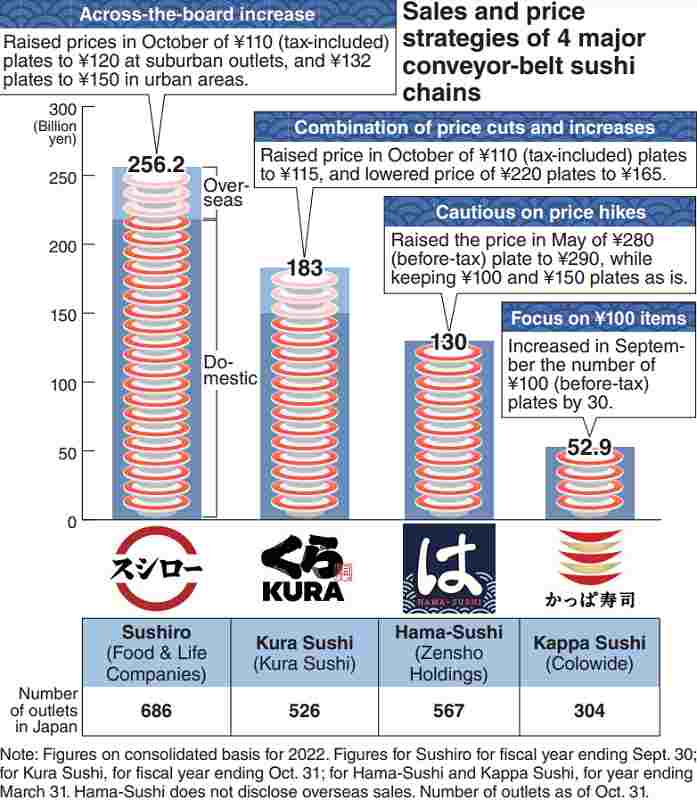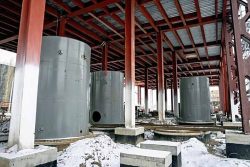
A Kura Sushi employee changes a price card on Sept. 30, the day before a price increase took effect, at an outlet in Osaka’s Minato Ward.
14:40 JST, December 31, 2022
The conveyor belts carrying the plates constantly advance in the same direction, but the giant sushi chains are diverging in pricing strategy as the days of the ¥100 plate gradually recede into the past.
Sushiro, the largest chain in the industry, had kept the cheapest items on its menu at a before-tax ¥100 from the time of its founding in 1984, but in October raised the price at most outlets by ¥10 to a tax-included ¥120.
While the restaurant sector as a whole took a major hit during the pandemic, the conveyor-belt sushi industry continued to expand by catering to the demand for takeout and other needs. It is regarded as fiercely competitive.
But because the most popular items such as tuna and salmon are imported, prices have soared due to rising shipping costs and the weak yen.
In the food service industry, restaurants generally allocate 30% of the menu price to covering the food costs, but for conveyor-belt sushi operators, the percentage rises to around 50%, making them particularly vulnerable to rising prices.
“It pains us to further burden the consumer, but it is necessary to preserve the deliciousness of the sushi,” said Koichi Mizutome, the president of Food & Life Companies Ltd. that operates Sushiro, on the price hikes.
As a result of the higher prices, Sushiro sales declined 18% to 25% on a same-store basis in October and November from the same months a year earlier, despite seeing a 2% increase in per-customer spending. The number of customers also declined between 20% and 27%.
Heeding customer comments of feeling they are getting less value for their money, Sushiro is hoping to regain lost ground through campaigns and other means.
Kura Sushi, Inc., the second-largest chain, also raised the price on its ¥100 items in October.
Internally, the company had considered hiking prices numerous times as far back as 10 years ago, when rises in seafood prices first became noticeable. But it endured the pain and left unchanged prices that had been in place for the 38 years since it first entered the conveyor-belt sushi industry.
However, with no end in sight to rising seafood prices, President Kunihiko Tanaka said the company had no choice but to raise its price by ¥5 to a tax-included ¥115 at most of its outlets.
On the other hand, Kura Sushi also lowered the price of ¥220 items to ¥165 “to at least slightly relieve the burden resulting from the price hikes.” Currently, 50% of the menu is comprised of ¥115 items and 20% is ¥165 items, while the remaining 30% is for special items such as those featured in campaigns.
The combination of price hikes and cuts and other means has resulted in a rise of about 5% in average customer spending on a same-store basis. The decline in the number of customers has remained steady at under 10%.
Some industry watchers speculate that Kura Sushi will displace Sushiro at the top if the latter doesn’t take further measures soon.

Trying to catch the leaders
On the heels of the two leaders is No. 3 Hama-Sushi Co., which has maintained its basic before-tax price of ¥100 for tuna, salmon and other main items. Its parent company, Zensho Holdings Co., which also operates the gyudon beef bowl chain Sukiya, is preparing to take the giants on from a position of financial strength.
“Since October, outlets with competitors in their neighborhood in particular are seeing good customer traffic,” Zensho Executive Officer Kiyohiko Niwa said.
The Kappa Sushi chain, which was the industry leader through 2010 until it was displaced by Sushiro and is currently fourth, also focused on keeping prices low. One way it could do this was by expanding the number of ¥100 items to about 80, an increase of 50%, in September.
“It is just a fact that they have no choice but to keep prices low to differentiate themselves from the top players,” said Nobuo Yonekawa, a conveyor-belt sushi pundit. “But because rising costs are having a definite effect, the ¥100 plate will eventually disappear as long as quality is not sacrificed.”
As the companies vie for market share with different pricing strategies, harmful effects from excessive competition have also surfaced.
In late October, a former president at Kappa Create Co., which operates the Kappa Sushi chain, was among those indicted on suspicion of violating the Unfair Competition Prevention Law. The executive allegedly obtained data illegally from his former employer, Hama-Sushi, such as product costs and suppliers, and sent it to an executive at Kappa Create after becoming an adviser to that company.
“The channels for purchasing seafood for standard sushi are limited to a few seafood suppliers,” said a senior official of another sushi chain. “But each chain operator’s uniqueness comes out through the bargaining skills for purchasing items available for a limited time. I can understand why they felt compelled [to take the data].”
There has been a spate of scandals in the industry, including one in June when a Food & Life subsidiary deceptively advertised products that were out of stock, drawing an administrative order from the Consumer Affairs Agency to take measures to prevent a recurrence.
"Business" POPULAR ARTICLE
-

Tokyo Economic Security Forum to Hold Inaugural Meeting Amid Tense Global Environment
-

Keidanren Chairman Yoshinobu Tsutsui Visits Kashiwazaki-Kariwa Nuclear Power Plant; Inspects New Emergency Safety System
-

Imports of Rare Earths from China Facing Delays, May Be Caused by Deterioration of Japan-China Relations
-

University of Tokyo Professor Discusses Japanese Economic Security in Interview Ahead of Forum
-

Japan Pulls out of Vietnam Nuclear Project, Complicating Hanoi’s Power Plans
JN ACCESS RANKING
-

Tokyo Economic Security Forum to Hold Inaugural Meeting Amid Tense Global Environment
-

Keidanren Chairman Yoshinobu Tsutsui Visits Kashiwazaki-Kariwa Nuclear Power Plant; Inspects New Emergency Safety System
-

Imports of Rare Earths from China Facing Delays, May Be Caused by Deterioration of Japan-China Relations
-

University of Tokyo Professor Discusses Japanese Economic Security in Interview Ahead of Forum
-

Japan Pulls out of Vietnam Nuclear Project, Complicating Hanoi’s Power Plans


























